Golden Retrievers are known as loving, friendly dogs. Poodles are considered to be one of the smartest breeds. No wonder that a cross between these two would be desirable! Additionally, because the Poodle is considered hypoallergenic, the Groodle is a great choice for people who are only mildly allergic to dogs.
Labradoodle Training
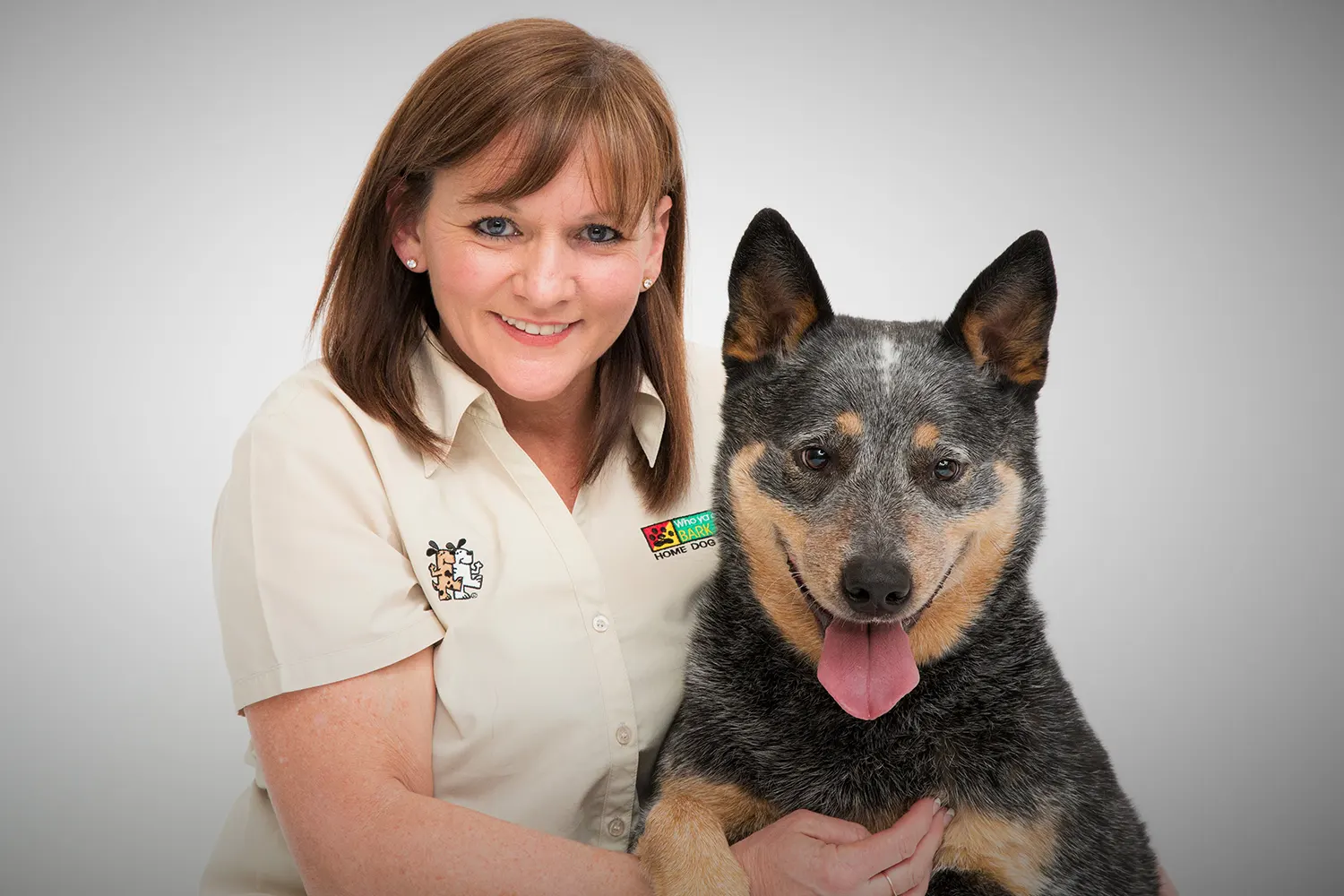
Bark Busters International Head of Training - Donna Ryan
Labradoodles are a cross between Retrievers and Poodles and usually share some of the best characteristics of each of those breeds. They are often highly intelligent, energetic, friendly, and outgoing, hence their popularity with active families. They want to be included in all the activities, but they also need to learn how to follow instructions, or their enthusiasm can get them in trouble. Specialist Labradoodle Training ensures they learn boundaries while maintaining their fun-loving personality.
Bark Busters trainers are often called to help the families of this breed of dogs, usually due to their over exuberance. Jumping on people, pulling on lead and not coming when called are common issues Bark Busters trainers help the families address through consistent Labradoodle Training.
Usually, these problems are easily taken care of as they are smart and want to please and fit in. As adorable as they are, like all other dogs, they need an education to learn how to be good family members. Many of these dogs can be great therapy dogs once they outgrow their puppy exuberance. Early Labradoodle Training sets the foundation for this lifelong behaviour and makes the learning process enjoyable for both dog and family.
As with Retrievers, their bodies mature faster than their brains and they often aren't fully mature until they are two years older, or even older. Starting their education as soon as you bring one home and making education a part of the normal routine will help them. Bark Busters trainers are experts at helping families develop a game plan for teaching these enjoyable dogs everything they need to know to be the great family members they can be. Their mums and siblings taught them how to live with dogs, it's up to us to teach them how to live with people. It is a great way to increase the bond with them as they love learning. Exercising their brains will help them be calmer and as they are high energy dogs to begin with, that’s usually a good thing, and all part of effective Labradoodle Training.
If you are considering getting a Labradoodle, do your homework, find a reputable breeder and contact your local Bark Busters trainer so you can get started on teaching them right away. If you aren’t controlling their education, your puppy will not know your family's vision. Only you can teach your puppy how to be the wonderful companion and family member they can be, with proper Labradoodle Training guiding the way.
About the Doodle
They are referred to as 'toy dogs', 'hybrids' or 'designer dogs'. Relatively new on the scene, Labradoodles made their debut in Australia in the 1980s and have quickly grown in popularity around the world. Why? They are a cross between a Labrador or Retriever and a Poodle, two well-loved breeds that are adorable and smart.
Bark Busters has trained "oodles of doodles", so before you go head-over-heels for your doodle and totally spoil them, it is important to know that behaviour problems come with their breed with naughtiness and stubbornness being two personality traits. Labradoodles will have the traits of both the Poodle and the Labrador or Retriever, both generally stable breeds, but sometimes the mix of the two is a cocktail of rowdiness and wilfulness. The good news is that this is nothing that dog training can't overcome.

History
Known as Labradoodles, Groodles, Goldendoodles, Golden Poos or Goldie Poos this breed has a short history. There is conflicting information on where this breed originated, with some saying Canada and some saying Australia. We do know they became popular in Australia in the 1980s and appeared in North America in the 1990s. As pet owners were looking for a larger dog that was allergy free, a Golden Retriever was bred with a Standard Poodle and there was instant fame!
The original designer breeds came into being when it was discovered that recipients of dogs used as 'seeing eye' and 'service dogs' were allergic to pet fur, so a dog that does not shed was sought.
Since Labradoodles are not pure bred and they are cross bred, they are not recognised as a breed of its own. They vary in size and physical appearance, depending on if they look more like a Labrador / Golden Retriever or a Poodle. You will see longer, shaggy-haired versions or a shorter, curlier hair type. When the fur is not cut, it will grow 4 – 8 inches in length and can grow long around the eyes. Therefore, it needs to be clipped regularly so your dog can see! These adorable fur kids come in a large colour selection of cream, gold, apricot, chocolate, grey and black.
Standard Labradoodles weigh 20 - 45 kgs, medium size weigh 14 - 20 kgs, and miniature weigh 7 - 14 kgs (mum or dad being a toy poodle).
When we say that Labradoodles are 'designer dogs', we mean they are first generation hybrids. If they are bred from a purebred Poodle and a purebred Labrador or Retriever, this is known as 'hybrid vigour'. This means you get the best characteristics of both breeds and are thought to be even healthier than their parents.
Management

If you have a Labradoodle, you have your hands full. They have boundless energy and a hard time focusing. They can be extremely naughty and mischievous and well known for chewing, nipping and mouthing everything in sight! Door manners - they never heard of them.
Dogs learn how to communicate with others when they are first born, mimicking their mum and siblings. We adopt them into our home, and we start speaking a language they don't understand. Dogs don't communicate with each other in the same was as humans. That is why our Bark Busters trainers teach pet owners how to communicate with dogs the natural way, with voice tones and body language. We call it 'speaking dog'.
The best time for training is when they are a puppy. You are going to need a lot of patience because consistency will be the key. Just when you think they have grasped the "sit" command, something will catch their attention and off they go. It is important for pet parents to establish themselves as the 'leaders' or your Labradoodle will push for control, and if you give an inch, they may just take a mile!
Your dog will quickly learn where they fit in the family pack, but they will tend to push the boundaries to see how far you are willing to go. They may constantly question your leadership and try to gain control of situations, especially where there is something to gain.
As Labradoodles have high energy levels, they need a lot of mental and physical stimulation. Multiple walks per day and some interactive toys such as the GameChanger® will help. They will shadow you everywhere you go and don't like to be left alone. If you're going to work, or you will be gone for the day, make sure you leave them with things to do or their destructive behaviours will kick in out of boredom.
One word of advice: Although great family companions, Labradoodles don't tend to make good watch dogs, so don't put them in a situation where they are guarding.
Personality and Temperament
Labradoodles are popular because they have the easy going, friendly nature of the Labrador or Golden Retriever and the brains of a Poodle. They are so cute it is hard to resist their enthusiasm. Due to their social nature, separation anxiety can be a big issue with this breed.
Capabilities
Labradoodles are extremely empathetic and really want to assist people who need a helping hand … or paw! Their extreme loyalty and gentle nature and quickness in learning make them ideal service dogs. They also make great therapy and guide dogs and can make wonderful companions for:
- People who are blind or partially sighted
- People in care homes
- Older people
- Hospital patients
- Emotional support dogs
Health
Everyday Illnesses and Injuries
Your Doodle's health concerns will change over the course of their life. A puppy might be more prone to eating something they shouldn't, a 2-year-old Doodle may be more likely to show signs of allergies, and a senior Doodle is far more likely to develop a mass as they age. Labradoodle's also have personality and physical traits that may make them more prone to certain conditions. This breed can be particularly playful, curious, and rowdy, and they can get into things they shouldn't and injure themselves along the way.

Genetic Health Concerns
Despite being a hybrid of two breeds, they have their fair share of hereditary based issues inherited from the Poodle and Retrievers. These include things like Addison's disease and hip dysplasia. Most reputable breeders now have their breeding stock checked and scored for these hereditary ailments by a veterinarian. You should request proof that the puppy you are purchasing comes from parents that have been checked for these issues.
As many other health issues are also hereditary, you should do some research on the ancestry of your puppy and any health issues of that particular breed.
Many dog rescue centres also check for common ailments before making them available for adoption.
Grooming

Labradoodles can take a lot of maintenance. One of the most challenging tasks to having a Doodle is keeping them well groomed. Just like ours, their hair keeps growing and gets unmanageable and dense, if not cut regularly. Doodles tend to have more hair in their ears and around their eyes, so they need to be groomed and cleaned regularly to allow air flow to travel in their ear canals. Their hair can be easily matted so it is important to brush them twice a week.
Puppies need to start having regular dental care at two months and will have their adult teeth by 8 months. Brush your dog's teeth with pet toothpaste because human toothpaste can upset their stomachs if swallowed. Like some other breeds, their eyes tend to weep, so wipe them daily with a warm cloth or pet wipes.
Behaviour Problems
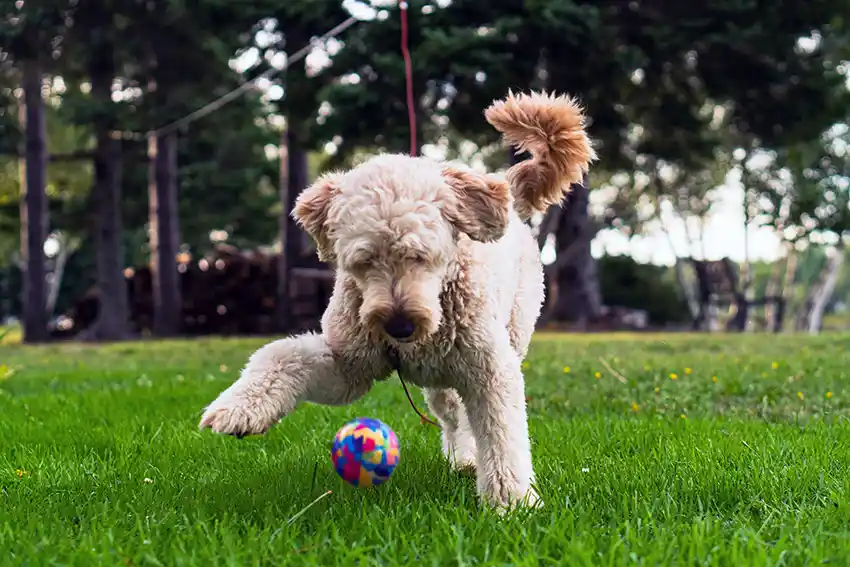
Everybody is a friend to a Labradoodle, and they thrive when they are around people. However, they do not like to be alone for long periods and will become destructive if they aren't getting the attention they need. They can have a hard time with Separation Anxiety.
If your dog is bored, you'll know it because the destruction begins. This is when dogs tend to misbehave the most.
It is important not to spoil your dog too much to the point where you accept misbehaviours. It is hard when they look like adorable teddy bears, but there is a major difference between loving and spoiling your dog. They do not do well with aggressive or harsh training because they are very sensitive. Labradoodles respond best to positive reinforcement. They live for belly rubs and sloppy kisses.
Puppy Selection
It is always better to get the right temperament puppy for your family, over picking one based on colour or gender. A pretty face will not matter much if you and your puppy do not get along and does not fit in well with your family's lifestyle.
It is important that you don't remove a puppy from their mother litter before 8 weeks, but 12 weeks would be even better. The time they spend with their mother and siblings is critical to their development. Puppies removed too early tend to be nervous, bark a lot, and bite because appropriate behaviour is learned at their mother's teat. Many long-term behaviour problems can be attributed to a puppy being removed from the litter much too soon.
Socialisation is learned with their littermates, and one that should be ongoing too. Although they are social creatures and generally get along with both people and other dogs, there are always exceptions to the rules. It is important to introduce your dog to new experiences and people, but it must be done carefully and without fear. Never take your dog into fearful situations because traumatic experiences can result in lifelong anxieties.

Introduce your puppy carefully to other dogs that you know could serve as a good role model. Dogs learn a lot from other dogs. Just like you don't want your kids hanging out with bad influences, the same rule should apply to dogs too.
Always choose a reputable breeder and ask for references. Labradoodles are a 'designer dog', and they can often cost a pretty penny. That's why we suggest looking at rescue centres, animal welfare shelters or the RSPCA. These dogs are tested for temperament and soundness before being put up for adoption.
If you want a 'Miniature Doodle', make sure one of the parents is a toy poodle or you will have a much bigger dog on your hands than you expected.
Four Basic Needs

As a responsible dog owner, your dog depends on you for four basic needs.
Let's examine those four basic needs and why your dog needs them to keep it healthy, balanced and content.
Food - diet / nutrition
The size of your Doodle will determine the amount of high-quality food your dog needs to eat. Bark Busters has found that certain foods can adversely affect your dog’s behaviour. You will want to check with your vet on the best nutrition for your Doodle.
Consult with your veterinarian about which brand of food you should purchase, or which raw diet is best for your dog. Your dog's diet is important to meet his nutritional needs and to maintain his overall health. As they are so small, you don't need a lot of food to fill them up!
We promote a diet that is grain free, low in carbohydrates and without any harmful e-numbers, colours and preservatives. Carbohydrates do add energy that the dog needs to burn off and can make an already hyperactive dog more active.
The right diet, grain free and filled with fruits, vegetables and raw meat will have advantages to how your dog will feel, look and act.
If you want to understand why grains can make a dog more energetic, you only need to think of racehorses and how their trainers give them grain to get highly energetic racehorses. Energy in, equals energy out.
Bark Busters dog trainers are not vets or dietitians, so we urge you to do your own research into the best diet for your dog. A diet that you will be comfortable with.
We do however have vast experience of how highly concentrated grain diets effect behaviour and can cause hyperactivity. This is very prominent in Japan, where most dogs are fed high levels of rice in their diet which can adversely affect concentration and focus.
Shelter - a place to call their own
Dogs love nothing better than to curl up on the couch or in a place they can call their own, even when there is more than one dog. The Doodle's are very sociable, and they will think nothing of all snuggling in together. Provide your dog with its own "den", a place where they can call home, and somewhere they can go to for a bit of peace and quiet. Just make sure their "den" is warm, easy to clean and maintain.
Safety - through leadership and education
All dogs need strong leadership and to know where they fit into the family unit. If they know they have a leader that will make all the decisions, one who is fair and just, they will be happy and content.
On the other hand, if they have no structure in their life, they have inconsistency, and don’t know how things will be from one day to the next, then they will become stressed and may experience health ailments, skin and stomach issues and behaviour problems. Routine and respect must be established. With equal doses of love and structure your dog will feel safe and secure.
Your dog just wants to please you but many times they don't know how. If you don't quickly establish yourself as the leader, your dog may gladly assume this role and chaos could follow.
Entertainment - toys and games
A very important part of your dog's four basic needs is their need to have something to do. If we want to avoid our pets becoming bored and destructive, then they need a way to fill their day.
Dogs thrive with physical and mental exercise. Dogs are highly intelligent animals, and they need to keep their brains active as much as their bodies. Entertainment is an important part of their well-being and essential to your dog's overall mental health.
One great toy is the Bark Busters GameChanger® which helps to prevent boredom, stress, and separation anxiety. By filling it with small treats, your dog will have plenty of fun trying to get the treats to dispense.
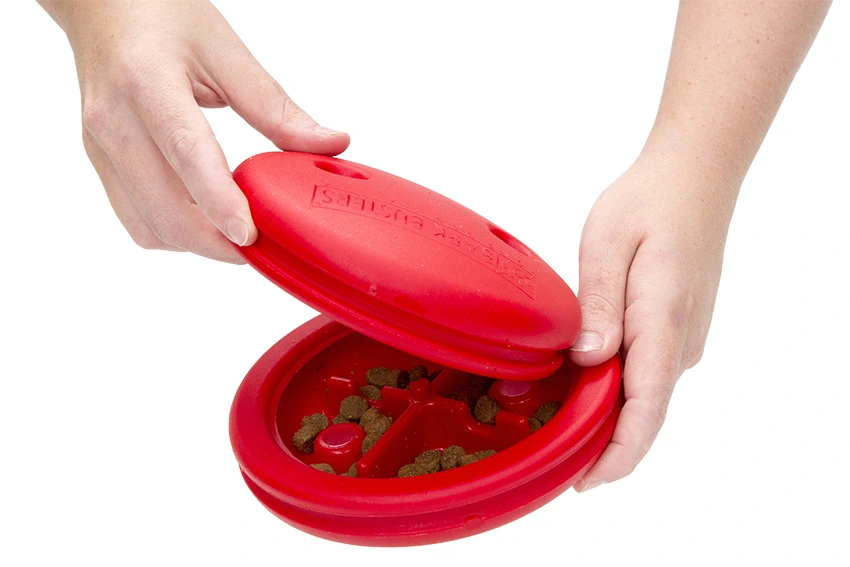
Games to Play
The Labradoodle's history, along both parent lines, is as hunters and water dogs. However, modern day Doodles have not been raised to hunt. Instead, they are great athletes who love to play flyball, tug-of-war, agility, hide-and-seek, fetch-and-retrieve and other outdoor canine sports. They need at least 30 minutes of exercise twice per day, which can include walking, swimming, playing with other dogs, or trotting behind you as you potter in the garden. Remember that whatever you do, they will want to be by your side!
Remember the old parlour game called three card Monte? Dogs love it. Take 3 cups and turn them upside down. Place a treat under one of them and mix them all up until you are sure your dog has lost track. Place the cups a few feet apart and see if your dog can guess which one contains the treat. If they guess wrong, don't give them the treat yet. Instead, show them the treat and mix the cups up again. Eventually their sense of smell will kick in and they'll get it right.
Alternatively, hide a treat in a room while your dog is watching. Pretend you are leaving it at one location, but visit multiple locations, leaving only one treat in one place. Have your dog sit until you give the command to "fetch" or "find". See if they can find it.
Remember that they have endless energy, so it is better to wear them out mentally and physically. I promise that given time, they will curl up on the couch and be mentally exhausted!
If you're handy, consider building a fun obstacle course. PVC pipe can be inexpensive to buy and can create a great agility course.
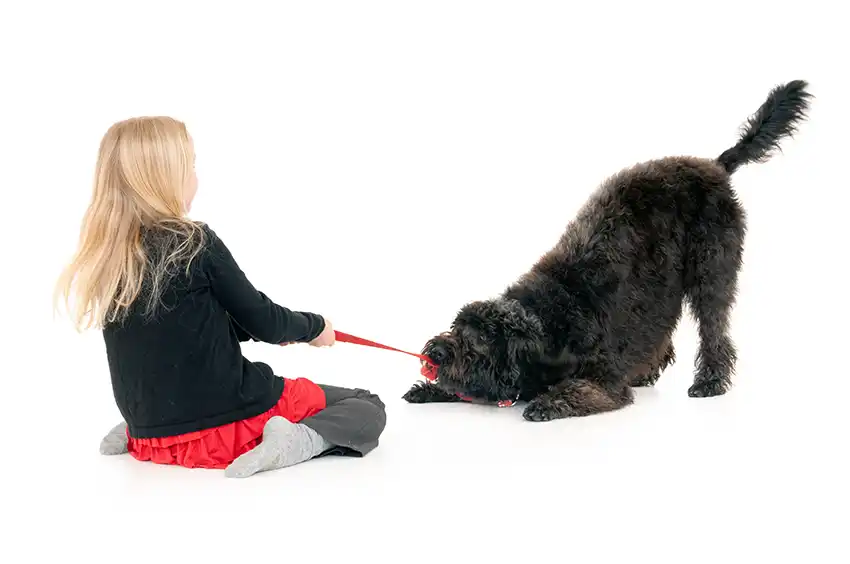
Child's Play
All dogs need to be controlled around babies or toddlers so as not to nip at them. They are intelligent and do learn quickly, so spend time educating them as to what is good and what is not. If you are patient and understanding of their capabilities, you will be able to enjoy many great times as a family with your dog.
Dog Parks
With today's dog owners having such busy lifestyles, more and more dog owners are turning to dog parks as a way of socialising and exercising their dogs. While this is great fun for most dogs and dog owners, not every dog will do well in this environment.
Breeds like a Labradoodle are high energy and love to run and chase. While this sounds like a perfect match for a dog park, owners must pay close attention to how their dog directs its focus. If your dog is allowed to run wild and herd other dogs, your dog will likely have high levels of adrenaline. While adrenaline can sometimes be helpful, if a dog becomes too focused on the wrong target in the dog park, this could quickly turn into a problem. If a dog doesn't enjoy being chased or nipped, they could feel threatened and become agitated. While the Doodle is just playing, if the dog being chased feels threatened and turns on them, this could escalate into a fight. As the dogs have no prior relationship and are in a high stress environment, this can easily happen.
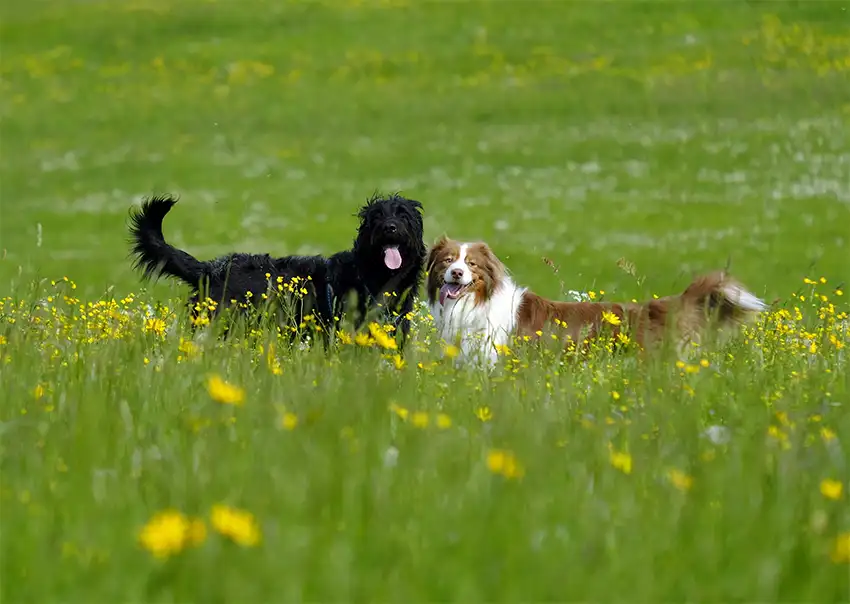
The best way to prevent this behaviour is to be sure you have strong voice control over your dog in low, medium and high level distraction environments before attempting to visit a dog park. Try visiting the dog park in off peak hours and practice gaining focus from your dog before you allow them to run off and play.
Bark Busters Lifetime Support Guarantee
Bark Busters dog behaviour therapists and trainers have trained more than 1 Million dogs worldwide and are renowned authorities in addressing dog behaviour with all-natural, dog-friendly methods. The Bark Busters training is the only service of its kind to provide International dog training guaranteed lifetime support. With hundreds of trainers around the world, Bark Busters continues its mission to enhance the human/canine relationship and to reduce the possibility of maltreatment, abandonment and euthanasia. Contact your local Bark Busters dog trainer to see how they can help.
This article is the copyright of Bark Busters® and is intended for information purposes only. Dog owners should fully research any problems that they may have with their dogs.



